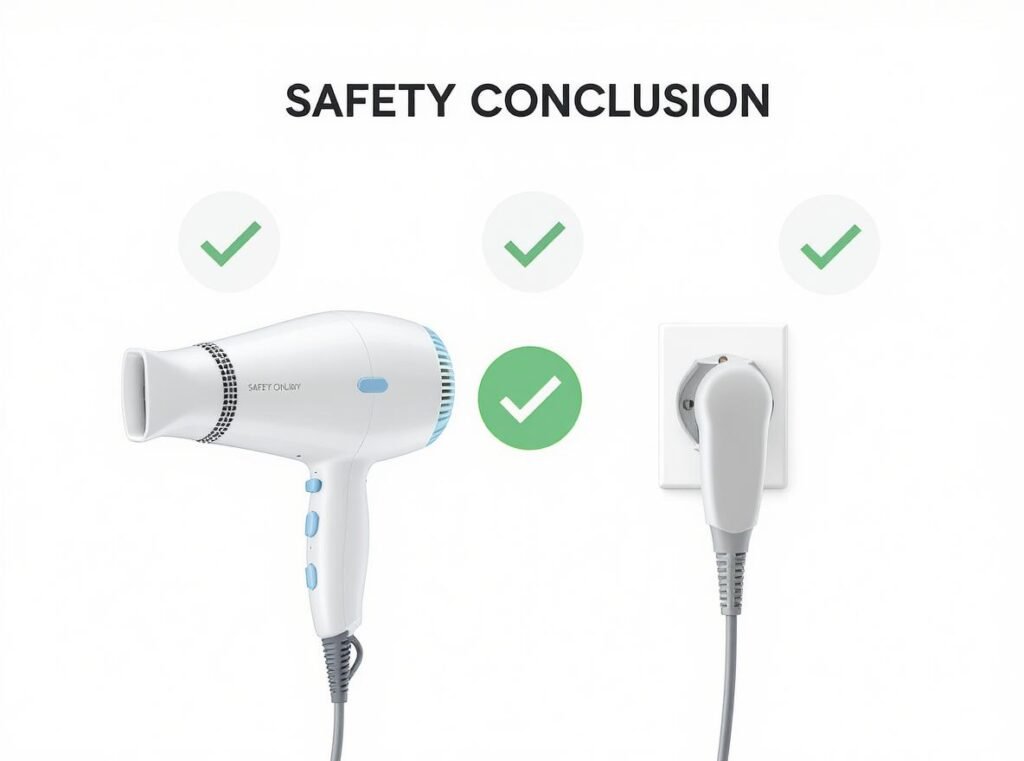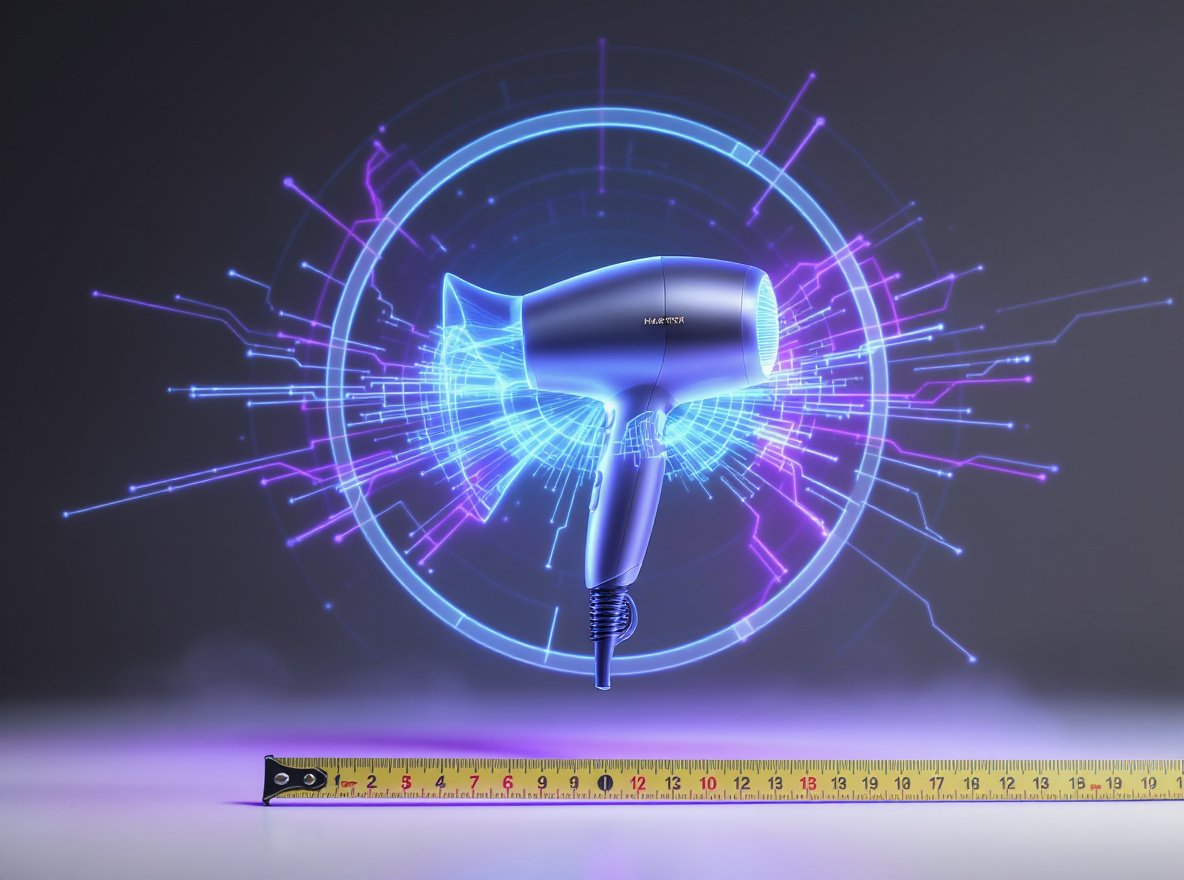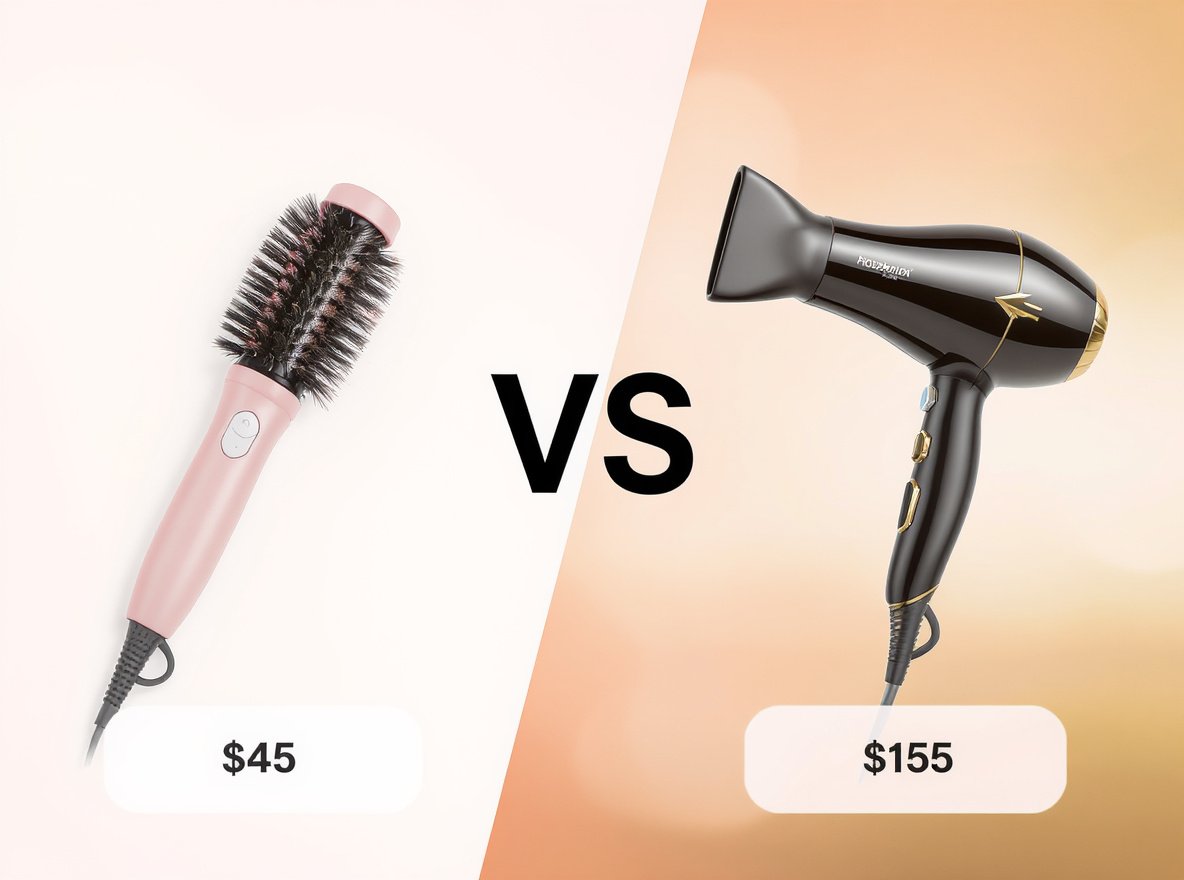Ever found yourself ready to style your hair, only to discover the outlet is just out of reach? You’re not alone. Many people face this frustrating situation and wonder about plugging their hairdryer into an extension cord. The consequences can range from minor inconveniences to serious safety hazards.
Using an extension cord with your hairdryer can lead to overheating, electrical fires, tripped breakers, and potential electrocution if the cord isn’t properly rated for high-wattage appliances. Hair dryers typically draw 1200-1875 watts of power, requiring heavy-duty extension cords with 12-14 AWG gauge ratings to handle the electrical load safely.
But there’s more to this story that could save you from costly damages and dangerous situations.
Table of Contents
ToggleCan You Safely Use an Extension Cord with a Hair Dryer?
Understanding the electrical demands of your hair dryer is crucial for making safe decisions about extension cord use.
Yes, you can use an extension cord with a hair dryer, but only if it’s a heavy-duty cord rated for at least 15 amps and 1875 watts with 12-14 AWG gauge rating and proper three-prong grounding. Using lightweight extension cords designed for low-power devices will create serious fire hazards.

Most hair dryers consume between 1200-1875 watts of power, which translates to approximately 10-15 amps of electrical current. This high power demand puts significant stress on electrical connections and wiring. When you use an inadequately rated extension cord, you’re essentially creating a bottleneck in your electrical system.
The key factors that determine safety include the cord’s gauge rating, length, and overall condition. A heavy-duty cord with a 12 AWG rating is ideal for powerful hair dryers, while 14 AWG is the minimum for average models. The lower the gauge number, the thicker the wire and the more current it can safely handle.
Even with these precautions, manufacturers and safety organizations generally recommend plugging hair dryers directly into wall outlets whenever possible. Professional electricians consistently advise against using extension cords with high-wattage appliances unless absolutely necessary.
What Are the Main Risks of Using Extension Cords with Hair Dryers?
The electrical demands of hair dryers create several potential hazards when combined with extension cords.
The primary risks include cord overheating leading to melting or fire, voltage drops reducing dryer performance, electrical circuit overload causing breaker trips, and increased risk of electrical shock from damaged or improperly grounded cords. These hazards occur because hair dryers are high-amperage devices that strain inadequate extension cords.

Fire Hazards and Overheating
Extension cords are responsible for more than 3,000 house fires annually, with many incidents involving high-power appliances. When a lightweight extension cord encounters the electrical demands of a hair dryer, several dangerous scenarios can unfold:
- Wire overheating: Thin or long cords increase resistance, causing dangerous heat buildup
- Insulation melting: Protective covering breaks down, exposing live wires
- Electrical fires: Overloaded cords can spark and ignite nearby materials
- Connection point failures: Plugs and sockets overheat at junction points
Performance and System Issues
Hair dryers require steady, high current to operate effectively. Inadequate extension cords create multiple problems:
| Risk Factor | Impact | Long-term Consequence |
|---|---|---|
| Voltage drop | Weak airflow, inconsistent heat | Reduced appliance lifespan |
| Circuit overload | Tripped breakers, power loss | Electrical system damage |
| Motor strain | Longer drying times, poor performance | Premature equipment failure |
Electrical Safety Hazards
Beyond fire risks, extension cords create additional safety challenges, especially in bathroom environments where hair dryers are commonly used. Improper grounding or damaged cords significantly increase the risk of electric shock, particularly dangerous in wet conditions.
Which Extension Cords Are Safe for Hair Dryers?
Not all extension cords are created equal, and choosing the right one is critical for safe hair dryer operation.
Safe extension cords for hair dryers must be heavy-duty with 12-14 AWG gauge, rated for at least 15 amps and 1875 watts, include proper three-prong grounding, and be as short as possible while meeting your needs. Light-duty cords with 16 AWG or higher ratings are completely unsuitable for hair dryer use.

Understanding Wire Gauge Requirements
The relationship between wire gauge and safe current capacity is crucial for extension cord selection:
- 12 AWG: Handles up to 20 amps, ideal for high-wattage hair dryers
- 14 AWG: Supports up to 15 amps, minimum for average hair dryers
- 16 AWG: Limited to 10 amps, inadequate for most hair dryers
- 18+ AWG: Under 10 amps capacity, dangerous for hair dryer use
Extension Cord Safety Classification
| Extension Cord Type | Gauge (AWG) | Amp Rating | Wattage Rating | Safe for Hair Dryers? |
|---|---|---|---|---|
| Heavy-duty | 12 or 14 | 15+ amps | 1,875+ watts | Yes, if short length |
| Medium-duty | 16 | 10 amps | Under 1,500 watts | No |
| Light-duty | 18+ | Under 10 amps | Under 1,000 watts | No |
Length and Construction Considerations
Extension cord length directly impacts safety and performance. Longer cords create greater electrical resistance, leading to voltage drops that reduce your hair dryer’s effectiveness while increasing heat generation in the cord.
Professional recommendations suggest keeping extension cords as short as possible, ideally under 25 feet for hair dryer applications. The cord must also feature proper strain relief, quality construction with UL listing, and GFCI compatibility for bathroom use.
What Happens When You Use the Wrong Extension Cord?
Using an inappropriate extension cord with your hair dryer creates a cascade of dangerous conditions that can escalate quickly.
Wrong extension cords cause immediate overheating, leading to cord melting, electrical fires, and potential electrocution. The cord may fail catastrophically while permanently damaging your hair dryer and potentially causing injury or property damage.

Immediate Warning Signs
When an extension cord is overloaded by a hair dryer, warning signs appear quickly:
- Cord overheating: The extension cord becomes hot to the touch
- Reduced dryer performance: Lower air flow and inconsistent heat output
- Electrical interference: Lights dim when the dryer operates
- Burning smell: Insulation begins to overheat and degrade
- Physical damage: Cord may melt, spark, or catch fire
Progressive Damage Stages
The damage progression typically follows this dangerous pattern:
Insufficient power delivery strains the hair dryer’s motor and heating elements. Voltage drops cause the appliance to work harder, drawing more current and creating additional heat. This increased demand further stresses the inadequate extension cord, creating a dangerous feedback loop.
As the situation worsens, the cord’s insulation breaks down, exposing live wires and creating shock hazards. The final stage involves complete cord failure, often accompanied by sparks, smoke, or open flames.
Long-term Consequences
Using wrong extension cords creates lasting problems that extend far beyond the immediate safety risks:
- Appliance damage: Reduced hair dryer lifespan and motor burnout
- Electrical system damage: Circuit breaker replacement and wiring issues
- Fire damage: Property loss and insurance complications
- Safety hazards: Increased risk of shock, burns, and electrocution
How Do Hair Dryer Power Requirements Affect Extension Cord Safety?
Understanding your hair dryer’s electrical demands is essential for making safe extension cord decisions.
Hair dryers typically consume 1200-1875 watts and draw 10-15 amps of current, requiring extension cords rated for at least 15 amps to provide adequate safety margins. Higher wattage dryers demand heavier gauge cords and shorter lengths to prevent dangerous overheating.

Modern Hair Dryer Power Consumption
Today’s hair dryers are more powerful than ever, with many models pushing electrical limits. Consumer-grade hair dryers typically range from 1200-1875 watts, while professional salon models can exceed 2000 watts.
Hair dryers require steady, high current to operate their motors and heating elements effectively. If the extension cord is too thin or too long, the resistance increases, causing voltage drops and overheating risks.
Calculating Electrical Load
Understanding the relationship between watts, amps, and volts helps determine extension cord requirements:
- Power (Watts) = Voltage × Current (Amps)
- 1875-watt dryer ÷ 120 volts = 15.6 amps
- Extension cord must handle 15+ amps minimum
Professional Equipment Considerations
The Conason P1C high-speed hair dryer exemplifies professional-grade design that balances power with safety considerations. When wholesalers and retailers stock high-quality dryers like these, they’re providing customers with appliances that deliver excellent performance while maintaining reasonable electrical demands.
Professional models often feature more efficient motors and heating elements, reducing overall power consumption while maintaining superior drying performance.
Are There Better Alternatives to Extension Cords for Hair Dryers?
Several safer alternatives exist for situations where your hair dryer cord doesn’t reach available outlets.
The safest alternatives include installing dedicated wall outlets near grooming areas, using hair dryers with longer built-in cords, repositioning furniture to access existing outlets, or choosing professional-grade hair dryers with extended reach. These solutions eliminate extension cord risks entirely.

Installing Additional Outlets
Working with qualified electricians to install properly placed outlets provides the safest long-term solution. Benefits include:
- Dedicated circuits: Prevent overloading shared electrical circuits
- GFCI protection: Required in bathrooms for shock protection
- Professional installation: Ensures proper grounding and code compliance
- Convenient placement: Eliminates need for extension cords permanently
Extended Cord Hair Dryers
Many professional hair dryers feature longer built-in cords specifically designed for salon and commercial use. These models typically offer:
- Extended reach: 8-10 feet for greater flexibility
- Heavy-duty construction: Built to handle high power safely
- Retractable options: Some models offer convenient cord management
- Professional features: Enhanced durability and performance
Portable Power Solutions
For off-grid or travel scenarios, portable power stations can provide safe alternatives, provided they meet the hair dryer’s wattage requirements. Solar generators and battery power stations offer independence from wall outlets while maintaining safety standards.
What Should Retailers Know About Hair Dryer Extension Cord Safety?
As wholesalers and retailers in the hair dryer market, understanding extension cord safety helps protect your customers and your business.
Retailers should educate customers about proper extension cord use, stock only heavy-duty cords suitable for high-wattage appliances, provide clear labeling with wattage and amp requirements, and promote GFCI-protected outlets for bathroom safety.

Customer Education Opportunities
Informed customers make safer purchasing decisions and experience fewer problems with their hair dryers. Key educational points include:
- Clear labeling: Display wattage and amp requirements prominently
- Safety warnings: Warn against using light-duty cords or power strips
- Proper usage guides: Provide guidelines for safe extension cord selection
- Alternative solutions: Suggest safer options when possible
Product Stocking Strategies
Stocking the right combination of products serves customer needs while promoting safety:
| Product Category | Recommendation | Safety Benefit |
|---|---|---|
| Hair Dryers | Extended cord models | Reduces extension cord need |
| Extension Cords | 12-14 AWG heavy-duty only | Handles high power safely |
| Outlet Solutions | GFCI-protected options | Adds bathroom safety |
| Accessories | Cord organizers, holders | Prevents damage and hazards |
When you offer high-quality hair dryers like the Conason P1C, you’re providing customers with appliances designed for safe, reliable operation. Professional-grade construction and thoughtful design features reduce the likelihood of electrical problems.
Liability and Safety Considerations
Providing comprehensive safety information with hair dryer sales helps protect your business while serving customers better. Consider including safety cards with extension cord guidelines, manufacturer recommendations for proper use, and contact information for technical support.
How Can You Minimize Risks When Using Extension Cords with Hair Dryers?
If you must use an extension cord with your hair dryer, following specific safety protocols can reduce risks significantly.
Minimize risks by using only 12-14 AWG heavy-duty extension cords rated for 15+ amps, keeping cord length under 25 feet, ensuring proper three-prong grounding, avoiding coiled cords, and regularly inspecting for damage. Never daisy-chain multiple extension cords or use them with power strips.

Pre-Use Safety Checklist
Before connecting your hair dryer to an extension cord, perform these essential safety checks:
- Verify specifications: Confirm AWG rating and amp capacity match requirements
- Inspect for damage: Look for cuts, burns, exposed wires, or worn insulation
- Check connections: Ensure tight, secure plug connections at both ends
- Test GFCI function: Verify ground fault protection works properly
- Clear the area: Remove tripping hazards and flammable materials
During-Use Safety Practices
While operating your hair dryer with an extension cord, maintain these critical safety practices:
Always use the shortest, thickest cord possible for your situation. Monitor cord temperature regularly by briefly touching it during use. Never run cords under rugs, carpets, or furniture where heat can build up.
Avoid coiling or bundling the extension cord, which traps heat and increases fire risk. Keep the cord away from the hair dryer’s hot exhaust air and never use the combination in wet conditions.
Post-Use Care and Maintenance
Proper care extends extension cord life and maintains safety standards:
- Unplug when not in use: Prevents unnecessary heating and electrical stress
- Cool down period: Allow cord to cool completely before storing
- Proper storage: Avoid tight coiling or sharp bends that damage wires
- Regular inspection: Check for developing problems before each use
What Are the Long-Term Solutions for Hair Dryer Power Access?
Addressing power access issues with permanent solutions provides better safety and convenience than relying on extension cords.
Long-term solutions include installing additional outlets near grooming areas, upgrading existing circuits to handle higher loads, using hair dryer holders for cord organization, and choosing professional-grade dryers with extended built-in cords. These approaches eliminate extension cord risks while improving functionality.

Electrical System Upgrades
Working with qualified electricians to upgrade electrical systems provides lasting benefits:
Modern bathroom outlets with GFCI protection and proper grounding ensure safe operation of all grooming appliances. Dedicated circuits prevent overloading and provide consistent power delivery for high-wattage devices.
Strategic outlet placement eliminates extension cord needs while maintaining clean, professional appearance in grooming areas. These upgrades also increase property value and improve overall electrical system reliability.
Professional Hair Dryer Selection
Choosing hair dryers designed for professional use often provides better cord length and construction quality. Features to consider include:
- Extended cord reach: Professional models often feature 8-10 foot cords
- Heavy-duty construction: Built for frequent, demanding commercial use
- Advanced features: Variable controls, ionic technology, and efficient motors
- Warranty coverage: Comprehensive protection for business and personal use
The Conason P1C high-speed hair dryer exemplifies these professional features, making it an excellent choice for salons, hotels, and discerning consumers who prioritize both performance and safety.
Grooming Space Organization
Thoughtful grooming area design can eliminate many electrical access problems:
Hair dryer holders and organizers keep cords tidy and reduce the need for extensions. Planning outlet placement during construction or renovation ensures adequate power access. Incorporating proper lighting and ventilation systems creates safer, more comfortable grooming environments.
Consider wall-mounted holders, built-in organizers, and cable management systems that contribute to safer electrical use while maintaining organized, professional-looking spaces.
Summary
Using extension cords with hair dryers creates significant safety risks including overheating, electrical fires, and potential electrocution. The key to safe operation lies in using only heavy-duty 12-14 AWG extension cords rated for high-wattage appliances, though permanent solutions like additional outlets provide better safety and convenience.

For wholesale buyers and retailers, stocking quality hair dryers with adequate cord lengths and educating customers about electrical safety helps protect both end users and your business reputation. Consider exploring our professional-grade hair dryer collection at Conason Products or contact us for wholesale inquiries about our P1C high-speed hair dryer and other safety-focused appliances.



